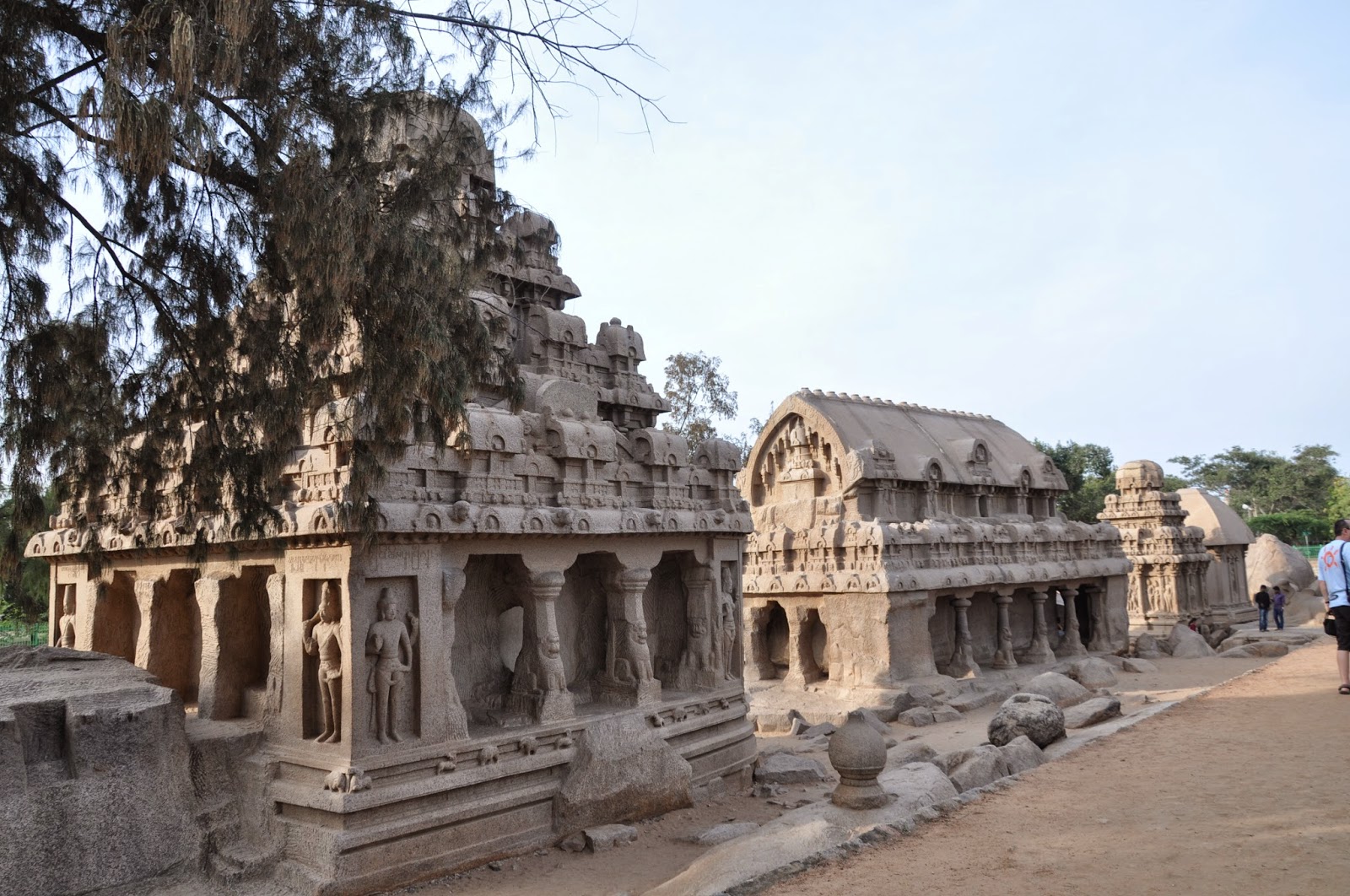I didn't know what to say as we approached the group of monolithic Monuments dating from the late 7th century and said to have been carved on single granite stones in the reign of the Palava king Mahendravarman I and his son NarasimhavarmanI. I thought after having seen what I had seen until then that nothing would astound me, but I was wrong. The chariot resembling (Ratha stands for chariot) monuments had me utterly surrendered to their beauty. Having been named after the Pancha Pandavas (the five acknowledged sons of Pandu by his two wives Kunti and Madri, who all married the same woman - Draupadi, despite having had multiple other wives) they have nevertheless no link to the iconic characters of the Mahabharata epic.

Amidst the "Rathas" one could see three life-size sculpted animals, a lion facing North, an elephant South and Shiva's mount West.


We started our visit around the ensemble with the smallest and simplest "Ratha", whose shape was a bangla hut with the Godess Durga 's representation decorating its outside and inside.

Inside it (underneath on the right) a sculpted Durga representation could be seen surrounded by devotees with one preparing to cut off his own head as a sacrifice.

The Arjuna Ratha resembling a small palace and pavilion stood close to the first Ratha. It had sculpted pilasters and a central sculpture showing Shiva with crossed legs leaning on Nandi.

Across from it stood an apsidal shaped Ratha with a barrel roof, the Nakula Sahadeva Ratha.
The large barrel vaulted shrine with a long columned porch with seated lions carved in its columns, the Bhima Ratha was probably the one that caught most people's attention and I believe it wasn't solely because of its size, but more so because of the carvings.


The octagonal shaped dome topping of the last Ratha we visited, the Dharmaraja Ratha, was quite interesting but so were some of the exquisite carvings, though I feel the importance of the whole ensemble and not any particular Ratha is intimately connected to the fact that it is believed the area served as a school for young sculptors, thus the different sculptures representing different styles of architecture, probably demonstrated by instructors and practised by young students.




Just before exiting the site I was drawn to a teenager wearing a bright yellow shirt which contrasted with the sand-like colour of the sculpted life-size bull he was sitting on ... though there was also something rather peculiar about his hair style that inevitably caught my attention (... false hair ... could it be?) ... he looked me in the eye ... and I didn't resist "catching" that look ...



Amidst the "Rathas" one could see three life-size sculpted animals, a lion facing North, an elephant South and Shiva's mount West.


We started our visit around the ensemble with the smallest and simplest "Ratha", whose shape was a bangla hut with the Godess Durga 's representation decorating its outside and inside.

Inside it (underneath on the right) a sculpted Durga representation could be seen surrounded by devotees with one preparing to cut off his own head as a sacrifice.

The Arjuna Ratha resembling a small palace and pavilion stood close to the first Ratha. It had sculpted pilasters and a central sculpture showing Shiva with crossed legs leaning on Nandi.

Across from it stood an apsidal shaped Ratha with a barrel roof, the Nakula Sahadeva Ratha.
The large barrel vaulted shrine with a long columned porch with seated lions carved in its columns, the Bhima Ratha was probably the one that caught most people's attention and I believe it wasn't solely because of its size, but more so because of the carvings.


The octagonal shaped dome topping of the last Ratha we visited, the Dharmaraja Ratha, was quite interesting but so were some of the exquisite carvings, though I feel the importance of the whole ensemble and not any particular Ratha is intimately connected to the fact that it is believed the area served as a school for young sculptors, thus the different sculptures representing different styles of architecture, probably demonstrated by instructors and practised by young students.




Just before exiting the site I was drawn to a teenager wearing a bright yellow shirt which contrasted with the sand-like colour of the sculpted life-size bull he was sitting on ... though there was also something rather peculiar about his hair style that inevitably caught my attention (... false hair ... could it be?) ... he looked me in the eye ... and I didn't resist "catching" that look ...




















No comments:
Post a Comment